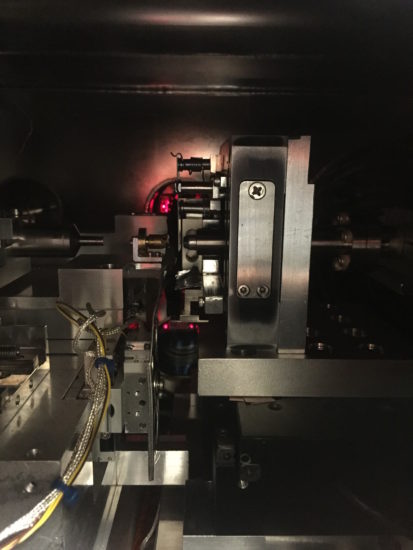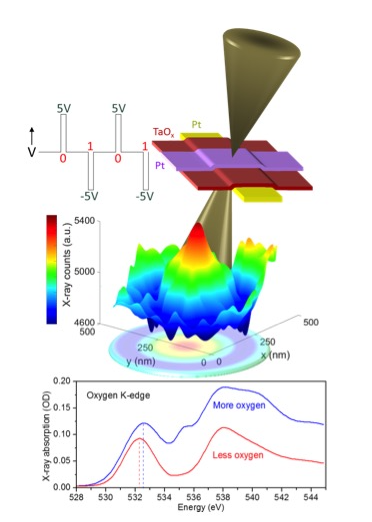For the past eight years, Hewlett Packard Labs, the central research organization of Hewlett Packard Enterprise (HPE), has been using cutting-edge ALS techniques to advance some of their most promising technological research. Hewlett Packard Labs researchers, including Suhas Kumar, Catherine Graves, and John Paul Strachan, recently made the cover of Applied Physics Letters with an ALS-based project that revealed key insights on how vanadium dioxide undergoes particular phase transitions. Another HPE/ALS project appearing on the frontispiece of Advanced Materials produced new insights on how atoms move during memristor operation.

Vanadium dioxide, a material that undergoes an insulator-to-metal phase transition with increasing temperature, could enable smaller, faster, and more energy-efficient electronic circuits for fast switching applications than even the best transistors currently in use. The nearly simultaneous electronic and structural transitions in vanadium dioxide are of significant scientific interest and have tremendous technological potential in computing, memory, optics, and micromechanics. Specifically, in memristor-based information storage, vanadium dioxide and related materials could be used as selectors to reduce operational power consumption, an active area of HPE’s research. Yet, the understanding of these specific phase transitions has been elusive for several decades due to inadequate probing technologies.
Using the unique combination of nanoscale microscopy and high-energy spectral resolution at ALS Beamline 11.0.2 and Beamline 5.3.2, Hewlett Packard Labs researchers spent three years collaborating with ALS scientists David Kilcoyne and Tolek Tyliszczak to develop a technique that enabled them to observe vanadium dioxide’s electronic and structural transitions separately. This capability gave them the basis for understanding the fundamental material properties and developing future applications and future research experiments.
“Vanadium dioxide is a really exciting material to study because it goes through many phase transitions, so you can essentially study several different materials while studying this one material,” says Hewlett Packard Labs researcher Suhas Kumar. “Using STXM (scanning transmission x-ray microscopy) techniques at the ALS allowed us to distinctly see that vanadium dioxide undergoes phase transitions in two stages—an electronic (Mott) and then a structural (Peierls) transition. So we basically discovered a third and fourth phase in a material that scientists have been studying for 60 years,” Kumar says.
“The key to this experiment was simultaneous access to extremely high spatial, spectral, and temperature resolution,” explains Kumar. “We had to build a temperature controller that would allow us to watch the vanadium dioxide change phase as the temperature changed, and we had to have the ability to tune that very precisely.”

While some of the real-world applications for this discovery are not short-term, the industries that are interested in using vanadium dioxide depend on the electronic and structural transitions separately, so a better understanding of it is key. HPE’s work at the ALS will further this understanding for the industry, Kumar notes.
“The opportunity afforded by the synergy of the goals of HPE and the ALS is very apparent with this collaboration,” says ALS scientist David Kilcoyne. “Both agencies are at the forefront of advancing the technological opportunites afforded by the innovation provided by this research in establishing this fourth passive device of electronics.”
“The exceptional spectral energy resolution at ALS simultaneously gives us information on the elemental composition, atomic structure, and electronic states within our devices, while the nanometer-scale spatial resolution enables us to image these properties on meaningful length scales without damaging the devices,” says HPE Senior Fellow Stanley Williams. “No other technique can provide all of this information in one experiment.”
HPE researchers have since applied some of the technology they developed at ALS for their vanadium dioxide research to study tantalum oxide, another material of interest in their memristor research. Memristors (short for “memory resistor”) are often described as the fourth basic circuit element, complementing the other passive elements—the capacitor, the resistor, and the inductor. The memristor has the ability to “remember” its state even when it loses power. Commercial development based on memristors as storage class memory, sometimes referred to as RRAM technology, offers the promise of memory-driven computing systems with orders of magnitude better power efficiency and performance than today’s mobile devices and computers for data intensive analysis.
The goal of the Hewlett Packard Labs researchers is to uncover material changes during resistance switching in tantalum oxide and related materials in situ and in operando, i.e., specifically observing the migration of atoms inside a functioning memristor during operation. HPE and ALS scientists, in collaboration with scientists at SSRL (Stanford Synchrotron Radiation Lightsource), built an in operando, synchronous, adaptive, time-multiplexed system that was capable of distinguishing very small signals originating from the local movement of oxygen atoms. The instrumentation, built on ALS STXM Beamline 11.0.2, can isolate spatial, spectral, and temporal (sub-microsecond) signals of very small intensity.

“Using this technique, we were able to directly observe spectral signatures of the lateral migration of oxygen atoms in tantalum oxide memristors,” says Kumar. “This resolved one of the active debates on what causes oxygen migration.”
“Our recent studies of tantalum oxide memristors allowed us to observe for the first time that oxygen ions were diffusing radially outward from a conduction channel in the device as it switched electrically to lower resistance, which confirmed the theoretical prediction that Joule heating and thermophoresis were important mechanisms for memristor operation and aging,” explained Williams. “This enhanced understanding enables us to upgrade our compact predictive models for the memristors, which in turn enables us to improve the devices and also the simulations of the circuits in which they are embedded.”
“The HPE/ALS collaboration has enabled remarkable advances in our understanding of oxide-based memristor technology,” says Kumar. “We have been able to make better choices of materials for memristors and we have also been able to improve the performance of our devices—for instance, the reduction in power of operation and an improvement in endurance by nearly 1000 times—which is critical for successful commercialization and deployment of this technology.”
“The scientific discoveries made during the course of this research are equally valuable for the research community,” he says. “We look forward to continuing this unique collaboration to advance technologies for improved computing systems and generate new scientific breakthroughs that can extend the frontiers of knowledge.”